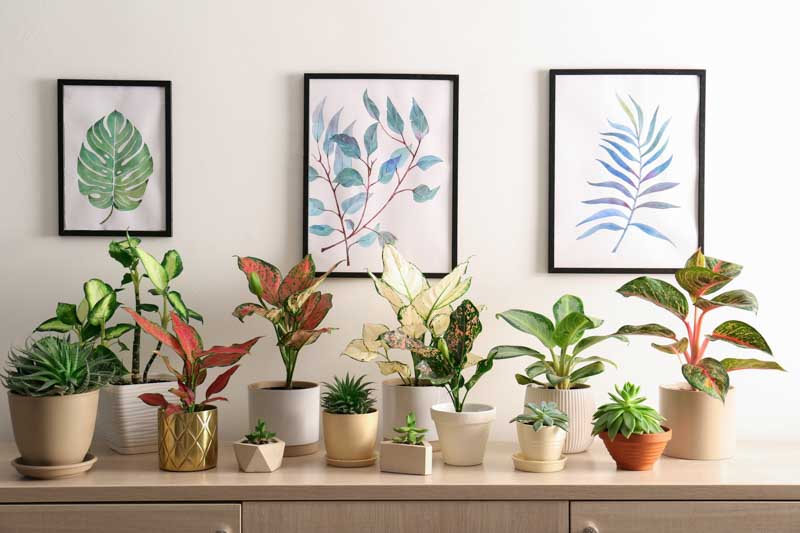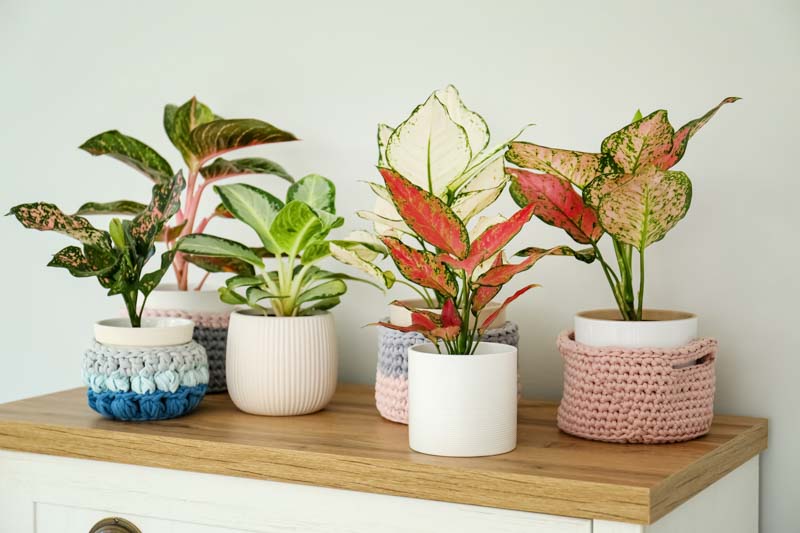Chinese Evergreen 'Silver Queen', Aglaonema treubyi 'Silver Queen', Aglaonema commutatum 'Silver Queen', Aglaonema nitidum 'Silver Queen'
Aglaonema ‘Silver Queen’, a jewel in the crown of indoor foliage plants, is celebrated for its striking, elegant appearance and its remarkable adaptability to indoor environments. Known for its lush, decorative leaves and easy-care nature, this variety of Chinese Evergreen is a favored choice for both seasoned horticulturists and beginners.
Aglaonema ‘Silver Queen’ features a dazzling display of silver-green foliage that immediately draws the eye. Each leaf is elegantly variegated with a blend of silver and green, creating a shimmering effect that enhances any space it occupies. The leaves are broad and lance-shaped, emerging gracefully from the plant’s center, creating a lush, full appearance that is both sophisticated and soothing.
Native: This cultivar is part of the Aglaonema genus, native to the tropical and subtropical regions of Asia and New Guinea. Like its relatives, it thrives in warm, humid environments. Aglaonema belongs to the arum family (Araceae), along with Zantedeschia (Calla Lily), Caladium (Angel Wing), Monstera (Swiss Cheese Plant), or Colocasia (Elephant Ear).
Plant Type and Habit: Aglaonema ‘Silver Queen’ is an evergreen perennial with a compact, bushy habit.
Size: The ‘Silver Queen’ variety of Aglaonema generally reaches a moderate height of about 1 to 2 feet (30 to 60 cm) and spreads similarly in width. Its contained growth makes it a perfect candidate for tabletops, shelves, and floor spaces without the worry of it outgrowing its designated area quickly. This manageable size contributes to its popularity in both home and office settings.
Flower: While it occasionally flowers, producing small, white, or greenish spathes, the plant is primarily grown for its foliage. The flowers are often inconspicuous compared to the stunning leaves.
Foliage: The foliage of the ‘Silver Queen’ is where this plant truly shines. Each leaf boasts a sophisticated pattern of silver and green, creating a stunning visual texture that can brighten low-light areas. The glossy finish of the leaves further enhances their appeal, making ‘Silver Queen’ a desirable choice for adding a touch of elegance to any interior.
Hardiness: This Chinese evergreen plant is hardy in USDA zones 10-12, meaning it’s not frost-tolerant and should be kept indoors or in a greenhouse in cooler climates.
Award: Recipient of the prestigious Award of Garden Merit of the Royal Horticultural Society.
Uses: Aglaonema ‘Silver Queen’ offers a multitude of uses in indoor settings. Its elegant appearance and air-purifying qualities make it an excellent choice for enhancing the aesthetic and environmental quality of living rooms, bedrooms, offices, and other indoor areas.
Toxicity: Like many Araceae, it is toxic if ingested due to calcium oxalate crystals. The juice can cause skin irritation and a painful rash. It should be kept away from pets and children who might chew on its leaves.
Benefits: Apart from its aesthetic appeal, it’s known for improving indoor air quality by filtering out pollutants.
Growing and caring for Aglaonema, commonly known as Chinese Evergreen, is quite straightforward due to its resilience and adaptability to indoor conditions.
Light: Aglaonema prefers low to medium light and can thrive in areas away from direct sunlight, which can scorch its leaves. It’s ideal for offices or homes with limited natural light.
Soil: Use a well-draining potting mix. A mixture designed for houseplants, which typically includes peat, pine bark, and perlite or vermiculite, works well.
Water: Water your Aglaonema when the top 1-2 inches of soil feel dry. Overwatering can lead to root rot, so ensure the pot has good drainage. They are somewhat drought-tolerant but perform best with consistent moisture.
Temperature and Humidity: Keep your Chinese Evergreen in a warm spot, with temperatures between 65°F to 80°F (18°C to 27°C). Avoid placing it in drafts or near heating and air conditioning vents. It’s sensitive to cold and should not be exposed to temperatures below 60°F (15°C). This plant enjoys high humidity (over 65%) but can adapt to lower humidity levels found in most homes. If your home is particularly dry, consider using a humidifier or placing the plant on a pebble tray with water to increase humidity around it.
Fertilization: Feed your Aglaonema with a balanced, water-soluble fertilizer every month during the growing season (spring and summer). Reduce feeding in fall and winter when plant growth naturally slows.
Pruning: Pruning is not typically necessary for Aglaonema, but you can trim away any yellowed or dead leaves to keep the plant looking its best. Use clean, sharp scissors or pruning shears.
Repotting: Repot your Chinese Evergreen every two to three years or when it becomes root-bound. Choose a pot slightly larger than the current one to give the roots room to grow.

Propagating Aglaonema (Chinese Evergreen) can be a rewarding way to increase your plant collection or share with friends. The process is relatively simple and can be done using a few different methods, primarily through stem cuttings or division.
This method is best performed when you’re already repotting the plant, typically in the spring or early summer.
Stem cuttings can be rooted in water or directly in soil.
Aglaonema cuttings root best in warm temperatures around 70°F (21°C). Patience is key, as it can take several weeks for roots to develop and new growth to appear.

Aglaonema, or Chinese Evergreen, is a resilient houseplant, but like all plants, it can encounter pests, diseases, and other common problems.
Spider mites: These tiny pests thrive in dry conditions and can cause the foliage to look dull and stippled. Increase humidity and wash the plant with water. In severe cases, use insecticidal soap or neem oil.
Mealybugs: Recognizable by their cotton-like white masses, they suck plant sap, weakening it. Remove them manually using a cotton swab dipped in rubbing alcohol or apply insecticidal soap.
Scale insects: These can appear as small brown bumps on the stems and leaves, sucking the sap and reducing plant vigor. Scrape them off or treat them with neem oil.
Aphids: These small, green pests suck sap from new growth. Rinse them off with water or treat the plant with neem oil.
Root rot: Overwatering is a common cause, leading to mushy, black roots. Ensure proper drainage and let the topsoil dry out between waterings. If root rot is detected, repot the plant into fresh, well-draining soil and trim away any rotted roots.
Leaf spot diseases: Fungal or bacterial infections can cause spots on leaves. Improve air circulation, avoid wetting the leaves when watering, and remove affected foliage. Fungicide treatments can be used in severe cases.
Yellowing Leaves: Often a sign of overwatering, poor drainage, or too much direct sunlight. Adjust watering habits and ensure the plant is not in a location where it receives harsh, direct light.
Brown Leaf Tips: Can indicate low humidity, too much fertilizer, or fluoride in the water. Use distilled or rainwater if your tap water is fluoridated, and mist the plant regularly to increase humidity.
Slow Growth or Pale Leaves: This might be due to inadequate light or nutrient deficiency. Ensure your Aglaonema is placed in bright, indirect light, and fertilize it with a balanced, diluted fertilizer during the growing season.
| Hardiness |
10 - 12 |
|---|---|
| Plant Type | Houseplants, Perennials |
| Plant Family | Araceae |
| Genus | Aglaonema |
| Common names | Chinese Evergreen |
| Exposure | Partial Sun |
| Season of Interest |
Spring (Early, Mid, Late) Summer (Early, Mid, Late) Fall Winter |
| Height |
1' - 2' (30cm - 60cm) |
| Spread |
1' - 2' (30cm - 60cm) |
| Maintenance | Low |
| Water Needs | Average |
| Soil Type | Loam, Sand, Chalk |
| Soil pH | Acid, Alkaline, Neutral |
| Soil Drainage | Well-Drained |
| Characteristics | Showy, Evergreen, Plant of Merit |
| Garden Uses | Patio And Containers |
| Garden Styles | Mediterranean Garden |
| Hardiness |
10 - 12 |
|---|---|
| Plant Type | Houseplants, Perennials |
| Plant Family | Araceae |
| Genus | Aglaonema |
| Common names | Chinese Evergreen |
| Exposure | Partial Sun |
| Season of Interest |
Spring (Early, Mid, Late) Summer (Early, Mid, Late) Fall Winter |
| Height |
1' - 2' (30cm - 60cm) |
| Spread |
1' - 2' (30cm - 60cm) |
| Maintenance | Low |
| Water Needs | Average |
| Soil Type | Loam, Sand, Chalk |
| Soil pH | Acid, Alkaline, Neutral |
| Soil Drainage | Well-Drained |
| Characteristics | Showy, Evergreen, Plant of Merit |
| Garden Uses | Patio And Containers |
| Garden Styles | Mediterranean Garden |
How many Aglaonema ‘Silver Queen’ (Chinese Evergreen) do I need for my garden?
| Plant | Quantity | |
|---|---|---|
| Aglaonema ‘Silver Queen’ (Chinese Evergreen) | N/A | Buy Plants |
Create a membership account to save your garden designs and to view them on any device.
Becoming a contributing member of Gardenia is easy and can be done in just a few minutes. If you provide us with your name, email address and the payment of a modest $25 annual membership fee, you will become a full member, enabling you to design and save up to 25 of your garden design ideas.
Join now and start creating your dream garden!
Create a membership account to save your garden designs and to view them on any device.
Becoming a contributing member of Gardenia is easy and can be done in just a few minutes. If you provide us with your name, email address and the payment of a modest $25 annual membership fee, you will become a full member, enabling you to design and save up to 25 of your garden design ideas.
Join now and start creating your dream garden!